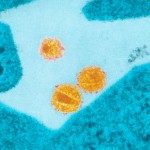Lien vers Pubmed [PMID] – 9188536
Science 1997 Jun;276(5320):1874-8
The human cytomegalovirus encodes a beta-chemokine receptor (US28) that is distantly related to the human chemokine receptors CCR5 and CXCR4, which also serve as cofactors for the entry into cells of human immunodeficiency virus-type 1 (HIV-1). Like CCR5, US28 allowed infection of CD4-positive human cell lines by primary isolates of HIV-1 and HIV-2, as well as fusion of these cell lines with cells expressing the viral envelope proteins. In addition, US28 mediated infection by cell line-adapted HIV-1 for which CXCR4 was an entry cofactor.

